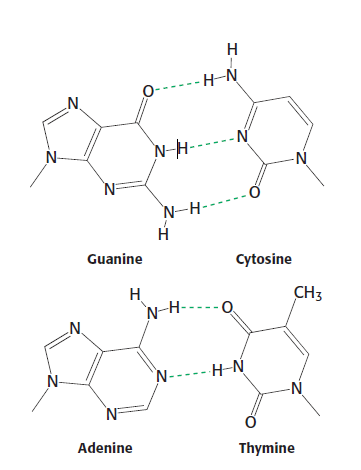Watson-Crick base pairs: Difference between revisions
Jump to navigation
Jump to search
Created page with "Watson-Crick base pairs is a specific complementary base pairs that base A is always paired with base T while base G is always paired with base C. <span style="line-height: ..." |
No edit summary |
||
| Line 1: | Line 1: | ||
Watson-Crick base pairs is a specific complementary base pairs that base A is always paired with base T while base G is always paired with base C. <span style="line-height: 1.5em;">These base pairs were introduced by </span>[[James Watson|James Watson]]<span style="line-height: 1.5em;"> and </span>[[Francis Crick|Francis Crick]]<span style="line-height: 1.5em;">. In Watson-Crick base pairs, t</span><span style="line-height: 1.5em;">he number of </span>[[ | Watson-Crick base pairs is a specific complementary base pairs that base A is always paired with base T while base G is always paired with base C. <span style="line-height: 1.5em;">These base pairs were introduced by </span>[[James Watson|James Watson]]<span style="line-height: 1.5em;"> and </span>[[Francis Crick|Francis Crick]]<span style="line-height: 1.5em;">. In Watson-Crick base pairs, t</span><span style="line-height: 1.5em;">he number of </span>[[Hydrogen bonds|hydrogen bonds]]<span style="line-height: 1.5em;"> formed between A and T are 2 while there are 3 formed between base G and C. <ref>Berg, J, Stryer,L ,Tymoczko J,2012, Biochemistry, 7th edition. W. H. Freeman and Company, New York. Pg. 114</ref></span> | ||
[[Image:Watson- | [[Image:Watson-Crick Base Pairs.PNG]]<ref>Berg, J, Stryer,L ,Tymoczko J,2012, Biochemistry, 7th edition. W. H. Freeman and Company, New York. Pg. 114, Figure 4.12.</ref> | ||
<br> | |||
=== References === | |||
=== References === | |||
<references /> | <references /> | ||
Revision as of 10:29, 25 November 2013
Watson-Crick base pairs is a specific complementary base pairs that base A is always paired with base T while base G is always paired with base C. These base pairs were introduced by James Watson and Francis Crick. In Watson-Crick base pairs, the number of hydrogen bonds formed between A and T are 2 while there are 3 formed between base G and C. [1]
